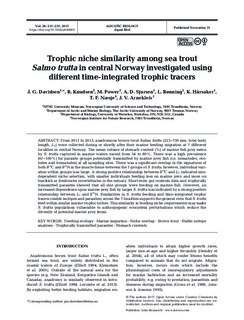| dc.contributor.author | Davidsen, Jan Grimsrud | |
| dc.contributor.author | Knudsen, Rune | |
| dc.contributor.author | Power, Michael | |
| dc.contributor.author | Sjursen, Aslak Darre | |
| dc.contributor.author | Rønning, Lars | |
| dc.contributor.author | Hårsaker, Karstein | |
| dc.contributor.author | Næsje, Tor | |
| dc.contributor.author | Arnekleiv, Jo Vegar | |
| dc.date.accessioned | 2017-11-24T09:46:40Z | |
| dc.date.available | 2017-11-24T09:46:40Z | |
| dc.date.created | 2017-09-28T09:05:52Z | |
| dc.date.issued | 2017 | |
| dc.identifier.issn | 1864-7790 | |
| dc.identifier.uri | http://hdl.handle.net/11250/2467966 | |
| dc.description.abstract | From 2011 to 2013, anadromous brown trout Salmo trutta (213−730 mm, total body length, LT) were collected during or shortly after their marine feeding migration at 7 different localities in central Norway. The mean volume of stomach content (%) of marine fish prey eaten by S. trutta captured in marine waters varied from 34 to 89%. There was a high prevalence (67−100%) for parasite groups potentially transmitted by marine prey fish (i.e. nematodes, cestodes and trematodes) at all sampling sites. There was a significant overlap in the signatures of both δ13C and δ15N in the muscle tissue between the 7 groups of S. trutta; however, individual variation within groups was large. A strong positive relationship between δ13C and LT indicated sizedependent niche selection, with smaller individuals feeding less on marine prey and more on brackish or freshwater invertebrates in the estuary. Short-term gut contents data and trophically transmitted parasites showed that all size groups were feeding on marine fish. However, an increased dependence upon marine prey fish by larger S. trutta was indicated by a strong positive relationship between LT and δ15N. Similarities in S. trutta feeding and time-integrated trophic tracers (stable isotopes and parasites) across the 7 localities supports the general view that S. trutta feed within similar marine trophic niches. This similarity in feeding niche requirements may make S. trutta populations vulnerable to anthropogenic ecosystem perturbations which reduce the diversity of potential marine prey items. Feeding ecology · Marine migration · Niche overlap · Brown trout · Stable isotope analyses · Trophically transmitted parasites · Stomach contents | nb_NO |
| dc.language.iso | eng | nb_NO |
| dc.rights | Navngivelse 4.0 Internasjonal | * |
| dc.rights.uri | http://creativecommons.org/licenses/by/4.0/deed.no | * |
| dc.title | Trophic niche similarity among sea trout Salmo trutta in Central Norway investigated using different time-integrated trophic tracers | nb_NO |
| dc.type | Journal article | nb_NO |
| dc.type | Peer reviewed | nb_NO |
| dc.description.version | publishedVersion | nb_NO |
| dc.subject.nsi | VDP::Zoologiske og botaniske fag: 480 | nb_NO |
| dc.subject.nsi | VDP::Zoology and botany: 480 | nb_NO |
| dc.source.pagenumber | 217-227 | nb_NO |
| dc.source.volume | 26 | nb_NO |
| dc.source.journal | Aquatic Biology | nb_NO |
| dc.identifier.doi | 10.3354/ab0689 | |
| dc.identifier.cristin | 1499332 | |
| dc.relation.project | Andre: Royal Norwegian Society of Sciences and Letters | nb_NO |
| dc.relation.project | Egen institusjon: UiT the Arctic University of Norway | nb_NO |
| dc.relation.project | Andre: NSERC | nb_NO |
| dc.relation.project | Egen institusjon: NTNU University Museum. | nb_NO |
| dc.relation.project | Egen institusjon: Norwegian institute for nature research (NINA) | nb_NO |
| dc.relation.project | Andre: County Governor of Sør-Trøndelag, | nb_NO |
| cristin.unitcode | 7511,3,0,0 | |
| cristin.unitname | Avdeling for akvatisk økologi | |
| cristin.ispublished | false | |
| cristin.fulltext | postprint | |
| cristin.fulltext | original | |
| cristin.qualitycode | 1 | |

